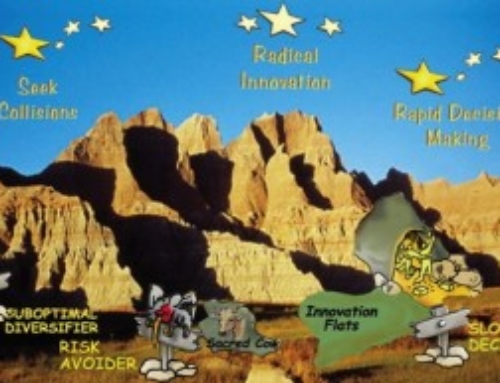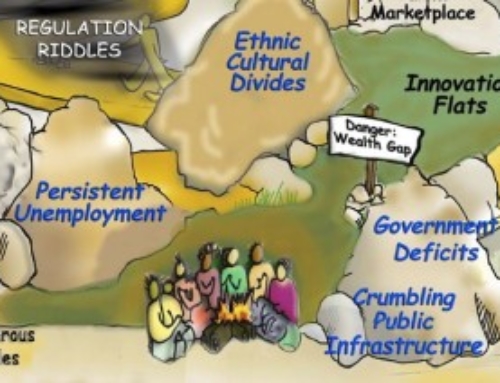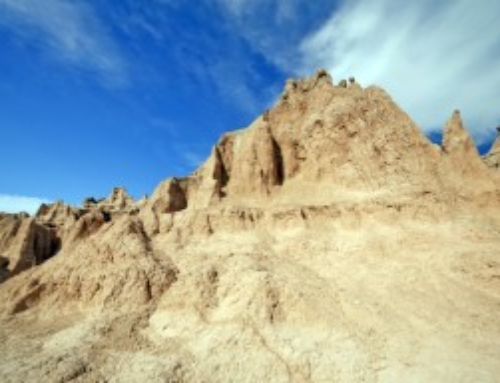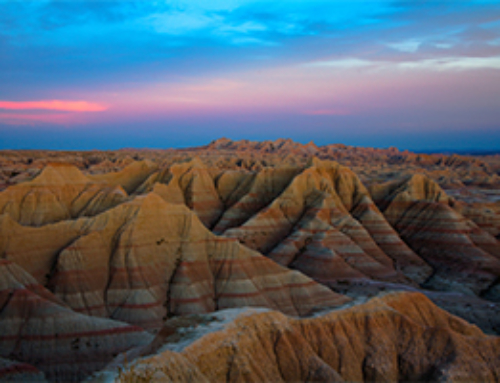In geographic parlance, “Badlands” are a type of terrain of soft, rocky soil often eroded by water and rain. Treacherous slopes, minimal vegetation, precarious gullies – and also dramatic canyons, soaring mesas and glistening waterfalls are found in the Badlands. Also found are capricious weather systems, dangerous predators and many risks. But throughout the settlement of such landscapes they have provided transition points to opportunity, to new ways of living and working toward the means for pioneers to create and design their own futures.
As mythic places of lore, Badlands occupy a niche in the campfire tales of America’s western migration, of hearty settlers braving the trails and travails toward promising horizons. But Badlands also represent this physical idea of challenge, risk and opportunity in other places, histories and cultures. From Spain’s “Bardenas Reales” to Italy’s “Calanchi” to New Zealand’s “Putangirua,” to Argentina’s “Valle de la Luna” to China’s “Xinjiang” — which means “New Territory” – diverse forms of Badlands hold a special place in both humanity’s reality and imagination.
And thus “The Badlands” has always been the central metaphor of Global Foresight. It is a way to conceptualize and embrace the invitation to embark upon a journey of discovery. It is the context in which the complex story of globalization is unfolding.
This is reflected, of course, in the title of the book by founder Mary O’Hara-Devereaux, “Navigating the Badlands: Thriving in the Decade of Radical Transformation.” Back in 2004 when we published this 332-page global forecast, many were those skeptical of our predictions about the features of this risk-strewn landscape: the impact of new technologies, global aging, growing terrorism and regional conflict, volatile stock markets and particularly, rising China. No longer. Time has confirmed the validity of this metaphorical portrait. And yet, however, this is not a landscape that we have yet to exit toward what we called then and now, “The Far Foothills of the Future.”
As we look ahead to the years 2025 to 2030, we ask ourselves: How do we get from here to there? How do we chart a path through the next long decade? Where will we experience considerable pain and bewilderment as one way of life ends and we grapple with how to create the next.
We have scaled many a dizzying Badlands cliff and traversed a number of slippery canyons in the last decade and a half. The Great Recession of 2008 for example, which Mary forecast, is behind us. What we then called “emerging economies” have now largely emerged. Few businesses remain intimidated by digital technologies. But new threats loom, from the real and irreversible impacts of climate change’s grip, to cyber crime; from the quickening pace of artificial intelligence’s rollout, to the rise of toxic leaders across the globe. So we are looking out at the next phase of this journey, from now to 2030, which will be all about creating the next new economy and re-inventing our social and political institutions in this globalized world.
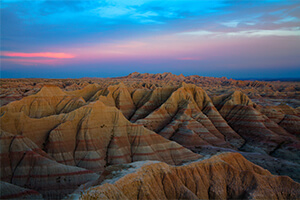 The Journey
The Journey
We all must pass through this rugged transition zone, adapting courageously and creatively to the comprehensive economic and social structural shifts under way, or perish by the wayside. Transitions are always painful, and escape is only an illusion.
These challenges are not centered on the ebb and flow of the business cycle or the stock market. This is not to say these factors will not be part of the journey. But focusing on them at the expense of understanding and responding to the larger forces at play will not lead to a good long-term outcome. They demand the application of the ‘8 Principles of Leadership to needed to Exit the Badlands’.
By using the data and insights in this series of articles – our “Badlands Blog” as we are calling it – we invite you to reach a deeper understanding of the powerful forces that even now are transforming the entire context of business. You will gain the opportunity to control your future, rather than be controlled by it.
Our new global context demands that we innovate to create and grow tomorrow’s industries and organizations. It further demands that we build new social institutions, such as a better health care system, and global organizations that can support our shared human goals, since business cannot thrive without a vibrant society and society cannot change if the economy is anemic.
“Our dream should be the creation of a vibrant, equitable and fully integrated global society underpinned by robust, worldwide economic growth. To realize this dream we need better, different kinds of leaders and organizations that will match the needs we will face in the new global reality. Today we have a mismatch.”
– Mary O-Hara-Devereux.
The decisions we make during this transition period will shape the new era. At the end of this process our very sense of identity will break apart, opening the way for the emergence of a new sense of self, appropriate to the new context.
As we confront the unavoidable need for individual and organizational metamorphosis, we must release patterns, mind-sets and behaviors that have no place in the Badlands and beyond. Putting an end to what no longer works is the next phase of any transition, and it is sure to be painful. But with each release we take a step forward, preparing ourselves for the confusing middle phase of this transition where, perhaps for years, nothing will feel solid or provide much continuity.
This is the second phase of all major transitions, in which we thrash about until we learn enough to begin anew. In this middle phase we must make huge social choices and experience their results, learning from our successes and failures. Then we must push on and make more choices. It is through making trade-offs in this environment of prolonged uncertainty and ambiguity that we will construct the new beginnings that lead to the third phase of the transition and the foundation of the next era. This will be an ongoing process of successive approximation.
It will take time and it will take guts.


